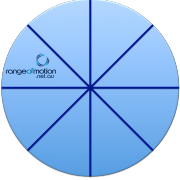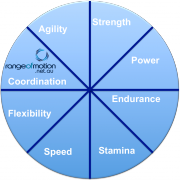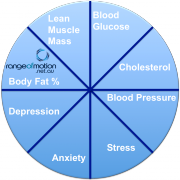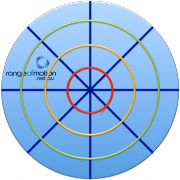The Range of Motion Model of Health sets down the principles for everything we do at Range of Motion.
The model resembles a ‘wagon wheel’ with individual spokes. Each spoke is required to keep the wheel circular. Should one spoke fail (even thought the others are still present), the wheel will change shape and cease to complete its function.
The Range of Motion Model of Health operates in the same way. Each spoke represents a component of health or athletic performance. The more spokes that are included in the model, the more complete a picture of your health and performance we can create. Any health or fitness/performance metric can be objectively applied to a spoke, with the model conceivably having an almost infinite number of arms. Whether it be components of physical fitness like strength or cardiorespiratory endurance; clinical measures like blood pressure or cholesterol; psychological measures like stress or depression; or body composition measures like body fat percentage or lean muscle mass.



How The Model Works:
Each of these variables and many more can be subjectively scored. The value can be indicative of sickness, wellness, or fitness. The more optimal the measure, the further that metric will be assigned to the outside of the graph.
The more metrics that are included, the more arms the graph will grow, and the better picture we get of your health. Once all measures are assigned, the points on the arms are joined.
We measure your health or physical fitness by the volume inside this curve. It will very quickly become apparent which of your measures are pathological or limiting performance. Should any spoke of the Model of Health fail (regardless of the strength of the other spokes), it will compromise the ability to sustain quality and quantity of life or maximise your athletic performance.


We contest that it is these measures (those indicated in red close to the axis of the model) that will not only reduce your quality of life, but may indeed kill you. From an athletic perspective, your deficiencies form the ‘weakest link’ in your performance and will cause sub-par results.
This paints a very clear picture of your health and fitness, and where we need to focus our efforts to get the maximum return. The aim is first to create as perfect a circle as possible, and once this has been achieved, to make the circle as ‘big’ as possible and thus maximising the volume of the circle (your health, fitness and performance).



How the Model Relates to Life and Human Performance:
Invariably, as we progress through life or competition, the wheel turns – and the spokes are tested. Jumping out of the way of a vehicle will test a ‘speed’ spoke. Surviving a fall may test a ‘bone mineral density’ spoke. Dealing with hardship may test a ‘stress’ spoke. A 5km time trial test a cardiorespiratory endurance spoke. Olympic Lifting tests a power spoke. Limitless components and scenarios exist.
These spokes may not be tested every day, every month, or even every year. But they will be tested. You cannot predict when, where or how. Regardless of the strength of the other measures, if an individual spoke fails, the wheel will cease to turn.
Through the application of this model our prescription of exercise is specific for the individual.





